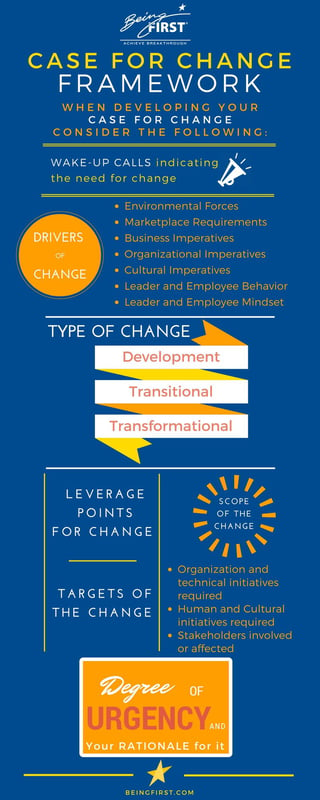What is a Case for Change?
When you initiate a change in your organization, your stakeholders and leaders will have questions about what is changing, why it is needed, the scope of the change, its urgency, outcomes, etc. Successful change leaders start with a case for change. Your case for change answers these questions so your impacted stakeholders and leaders can understand the purpose for small or large-scale transformation initiatives.
Your case for change is different than your business case. A business case typically outlines the financial requirements and incentives for the project. Your case for change and desired outcomes will engage employees and convey to your stakeholders why they should invest in the effort required by the change. It is the statement that informs and compels them to engage and contribute. If they don’t understand the “why,” they won’t get on board. Financial goals, while important, may not be seen by stakeholders as directly ensuring their job security, for example, or for creating a satisfying work environment.
A Case for Change Ensures Stakeholder Engagement
Your case for change is designed to motivate stakeholders to join in and make the change a success. Without a clear case for change, your change initiative will lack relevance for employees and may cause resistance, confusion, and insecurity. While some stakeholders may see change initiatives as an opportunity, others typically see the change initiative as a threat.
Creating the case for change and your initial objectives creates a common view about the change, ensures stakeholder engagement, and gives the effort meaning, direction, and energy.
What to Include in Your Case for Change
An effective case for change includes the following:
- The drivers of change, from environmental forces to business strategy, as well as organization, cultural, and behavioral requirements
- Type of change—developmental, transitional, or transformational
- Leverage points for changing the systems dynamics of the organization in support of the initiative
- Initial impacts that inform scope
- Target groups of the change: who must change
- Scope of the change
- Urgency for the change
 Building Your Case for Change
Building Your Case for Change
The information for your case for change may already have been generated through the organization's business strategy efforts. If so, take the exploration of the business strategy to the next level of specificity. Ask yourself “How does the business strategy require the organization to change?” Use the business strategy as input to your case to ensure that you have a complete picture and that your case for change is driven by your business strategy.
The elements of the case for change are very different than the typical “Scope, Schedule, Budget” that good project management requires. The conversations that make up your case for change precede and inform scope, schedule and budget. While a project team will ask for these three decisions, the case for change comes first and sets the stage for stakeholder buy-in.
Your case for change will be strengthened by clarifying the desired outcomes for your effort—what value you intend to produce. Your outcomes should communicate your vision for the outcome, the results you require, the benefits your organization will reap, and a picture or definition of success. These are different than your financial goals. You can communicate your financial metrics as well, but not as the ultimate end-game, as they do not reveal the “why.”
Who Owns and Builds the Case for Change?
Your senior leaders need to own the case for change as their unified direction. Otherwise, it becomes a nice document that sits on a shelf and does not drive the change forward. But who builds it? The leaders themselves can do this work, ideally guided by a change facilitator who understands the elements of a case for change and who can shape the leaders’ conversation and decisions. Drafts can be created by a project team, but their work must be understood by the leaders who are sponsoring the change initiative. Consider engaging your front-line employees and middle managers in creating your case for change. They add credibility for employees regarding the assessment of need, leverage points for change, and impacts. The participation of these stakeholders is an enormous catalyst for their understanding and commitment.
Consolidate the final case into a clear picture of the why and the what. This is often tailored to the various stakeholder groups so that it is most relevant to their particular needs and motivations.
RELATED RESOURCE





